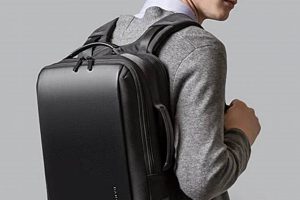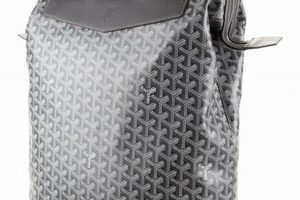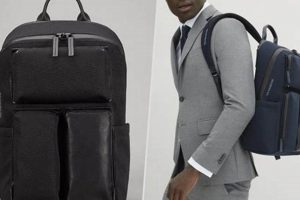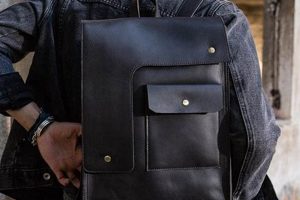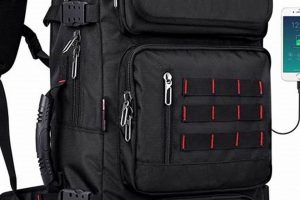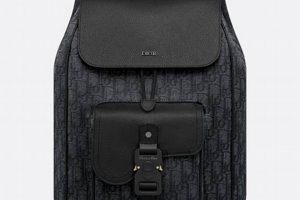This type of bag represents a fusion of design elements, combining the compact form factor of a sling bag with the utility of a backpack. Often characterized by a single shoulder strap worn across the torso, this carrying solution provides a hands-free experience. Examples include bags constructed from durable nylon with adjustable straps, multiple compartments for organization, and features tailored to accommodate items like tablets or water bottles.
The rising popularity of this configuration is attributed to its convenience and accessibility. It offers a practical alternative to traditional backpacks, especially in situations where mobility and quick access to belongings are paramount. Its development likely stems from the need for a comfortable, secure way to carry essentials in urban environments and during activities like cycling or hiking. It merges functionality with a modern aesthetic.
The following sections will delve into specific aspects of this product category, including considerations for choosing the right one, variations in design and materials, and relevant use cases across different lifestyles and activities.
Considerations for Selecting a Crossbody Backpack
Choosing the appropriate bag requires careful evaluation of several key factors to ensure optimal utility and comfort.
Tip 1: Assess Capacity Needs: Evaluate the typical volume of items to be carried. Smaller bags are suitable for daily essentials, while larger options can accommodate more substantial loads, such as books or electronics.
Tip 2: Prioritize Material Durability: Opt for materials like nylon or canvas known for their resistance to wear and tear. Reinforced stitching and water-resistant coatings enhance longevity, especially for frequent use.
Tip 3: Evaluate Strap Comfort and Adjustability: The shoulder strap should be adequately padded and adjustable to distribute weight evenly across the torso. Consider straps with breathable mesh for improved ventilation.
Tip 4: Examine Compartment Organization: Look for a variety of compartments and pockets to facilitate organized storage. Dedicated sleeves for tablets or phones, as well as key clips, can enhance convenience.
Tip 5: Consider Security Features: Bags with hidden pockets or anti-theft zippers can provide added security in crowded environments. RFID-blocking compartments can protect against electronic theft.
Tip 6: Evaluate Style and Aesthetics: Choose a design that aligns with personal preferences and intended use. Options range from minimalist styles to more rugged, utilitarian designs.
Tip 7: Verify Closure Mechanisms: Durable zippers, buckles, or magnetic closures ensure that belongings remain secure. Assess the quality of these components before purchase.
Proper selection based on these considerations ensures that the chosen bag effectively meets individual needs, offering a balance of comfort, functionality, and security.
The following section will address common use cases and explore how this bag can be integrated into various lifestyles.
1. Ergonomic Weight Distribution
Ergonomic weight distribution represents a critical design factor in the efficacy of this bag type. Because these bags are worn asymmetrically across the body, the potential for uneven weight distribution and associated strain is significant. Proper design and construction mitigate this risk through features such as padded straps, adjustable strap lengths, and strategically positioned compartments. When implemented effectively, these features distribute the load more evenly across the shoulder and torso, reducing localized pressure points. Failure to address this aspect can lead to discomfort, muscle fatigue, and, in prolonged use, potential musculoskeletal issues. For example, a poorly designed bag, overloaded on one side, will exacerbate strain on the shoulder and back muscles opposite the loaded side.
Achieving optimal weight distribution within this bag directly influences user comfort and carrying capacity. A well-designed bag allows for longer periods of wear without significant discomfort. Additionally, the placement of heavier items closer to the body’s center of gravity enhances stability and reduces the likelihood of the bag shifting during movement. Consider a scenario where a bag is used for carrying camera equipment. The strategic placement of the camera body closer to the back, with lighter accessories positioned towards the front, contributes to a more balanced and comfortable load. Adjustability in the strap length is also vital to accommodate diverse body types and carrying preferences, ensuring the bag sits securely without restricting movement.
In summary, ergonomic weight distribution is an indispensable element in the design and functionality of this type of bag. Attention to strap design, compartment layout, and adjustability directly impacts user comfort, carrying capacity, and long-term musculoskeletal health. A poorly designed bag negates the intended convenience of the design. Manufacturers prioritizing ergonomic principles create bags that are not only functional but also contribute to the user’s well-being. Neglecting this design aspect presents a significant drawback.
2. Accessible Storage Solutions
In the context of a crossbody backpack, accessible storage solutions represent a critical determinant of the bag’s practicality and user-friendliness. The design and configuration of compartments directly impact the ease and speed with which items can be retrieved, influencing the bag’s overall suitability for various activities.
- Strategic Compartment Placement
Compartment placement is a fundamental element of accessible storage. Crossbody bags often incorporate front-facing pockets for frequently accessed items like phones or wallets, while larger, zippered compartments secure less frequently needed belongings. For example, a photographer might utilize a front pocket for spare memory cards and batteries, while the main compartment holds a camera body and lenses.
- Dedicated Pockets and Sleeves
Specialized pockets and sleeves enhance organization and protect sensitive items. Padded sleeves designed for tablets or e-readers prevent damage during transport. Internal dividers create separate sections for items such as water bottles or documents, preventing them from shifting and potentially causing harm. For instance, a student might use a dedicated tablet sleeve and internal dividers to separate textbooks and notebooks.
- Quick-Access Features
Quick-access features, such as magnetic closures or external zippers, allow for rapid retrieval of items without fully opening the bag. This is particularly useful in situations where speed is essential, such as navigating crowded public transportation or participating in outdoor activities. Consider a commuter who needs to quickly access a travel card or headphones while on the go.
- Adjustable and Modular Systems
Some crossbody bags incorporate adjustable or modular storage systems, allowing users to customize the configuration of compartments to suit their specific needs. These systems might include removable dividers or MOLLE webbing for attaching additional pouches and accessories. This adaptability is beneficial for individuals with diverse carrying requirements, such as travelers who need to adapt the bag to accommodate different types of gear.
These facets highlight the importance of accessible storage solutions in the design and functionality of crossbody bags. A well-designed system enhances user convenience, improves organization, and protects belongings, ultimately contributing to a more efficient and enjoyable carrying experience. The absence of these features detracts from the intended purpose of the crossbody bag design.
3. Durable Material Construction
The longevity and reliability of this type of bag are fundamentally dependent on durable material construction. Materials employed in the bag’s manufacture directly impact its ability to withstand the stresses of daily use, environmental factors, and potential abrasions. The choice of materials is not merely an aesthetic consideration; it is a functional imperative. A bag constructed from inferior materials will exhibit premature wear, compromising its intended purpose of securely transporting belongings. For example, a bag made from thin, non-ripstop nylon may tear easily when exposed to sharp objects or excessive weight, rendering it unusable. In contrast, a bag constructed from ballistic nylon or reinforced canvas demonstrates significantly greater resistance to wear and tear.
Specific material characteristics contribute to the overall durability. Water resistance, provided by coatings or inherent material properties, protects contents from moisture damage. Tear resistance, often achieved through ripstop weaves, prevents small tears from propagating and causing catastrophic failure. Abrasion resistance, a key attribute of materials like Cordura, minimizes surface damage from friction. The selection of hardware, such as zippers and buckles, also plays a crucial role. Metal zippers offer greater durability compared to plastic alternatives, and reinforced stitching at stress points enhances the bag’s structural integrity. Consider a professional photographer who relies on a crossbody bag to transport valuable equipment; the bag’s ability to withstand harsh conditions and protect its contents is paramount. The use of high-quality, durable materials provides assurance of the bag’s performance and the safety of its contents.
In summary, durable material construction is an indispensable element in the design and utility of the discussed bag. The selection of appropriate materials, coupled with robust construction techniques, directly influences the bag’s lifespan, reliability, and ability to protect its contents. Compromising on material quality undermines the bag’s functionality and diminishes its value to the user. The benefits derived from durable materials extend beyond mere longevity, encompassing enhanced security, protection against environmental elements, and overall user satisfaction. Therefore, potential purchasers should prioritize material quality as a primary factor in their selection process.
4. Compact Size Advantage
The compact size advantage is intrinsically linked to the utility and appeal of the crossbody backpack. This bag’s design prioritizes a streamlined profile, offering a carrying solution that is less bulky than traditional backpacks. This reduced size enhances maneuverability in crowded environments, such as public transportation or busy urban streets. The effect of this compactness is a reduction in the physical footprint of the bag, allowing the wearer to navigate confined spaces with greater ease. Consider a commuter navigating a packed subway car; a traditional backpack can impede movement and potentially inconvenience fellow passengers, whereas the leaner profile of the other bag minimizes disruption. The bag design allows the wearer to maintain a smaller personal space.
The compact size also contributes to the bag’s suitability for activities where freedom of movement is paramount. During hiking, cycling, or even casual walking, the reduced size minimizes the potential for the bag to interfere with arm movements or create imbalances. The bag provides a comfortable and unrestrictive carrying experience. Furthermore, the diminished volume necessitates a conscious effort to prioritize essential items, promoting a more minimalist approach to carrying belongings. A traveler using this type of bag for day trips is compelled to carefully select the most crucial items, avoiding the tendency to overpack that often accompanies larger bags. This imposed discipline can lead to a lighter load and a more agile experience.
In summary, the compact size advantage is not merely an incidental characteristic; it is a fundamental design element that shapes the functionality and practicality of the crossbody backpack. It enables enhanced maneuverability, promotes freedom of movement, and encourages a minimalist approach to carrying belongings. While larger bags may offer greater carrying capacity, they often lack the agility and convenience afforded by the design. The bag allows the integration of ergonomic function with practical utility. Ultimately, the appreciation of this nuanced advantage fosters a more informed understanding of the bag’s appeal and its suitability for specific use cases.
5. Versatile Style Applications
The adaptability of this bag to diverse aesthetic preferences and functional requirements defines its versatility. Style applications are not superficial considerations; they are intrinsic to the bag’s widespread acceptance and integration into varied lifestyles. A bag lacking stylistic adaptability would find limited appeal, confining its use to niche applications. For instance, a brightly colored bag with overtly tactical features may prove unsuitable for professional settings, thereby restricting its versatility. This type of limited-application bag fails to meet the demands of individuals seeking a multi-purpose carrying solution, which has negative cause and effect to sale of the item.
Consider the practical significance of design variations. Minimalist designs in neutral colors, often crafted from materials such as leather or waxed canvas, lend themselves to professional and semi-formal environments. These bags can seamlessly transition from office settings to casual social gatherings without appearing out of place. Conversely, bags constructed from rugged nylon, featuring multiple pockets and attachment points, cater to outdoor enthusiasts and individuals requiring enhanced functionality. These bags are well-suited for hiking, cycling, or travel, where practicality takes precedence over aesthetics. For example, a design incorporating molle webbing supports customization with specialized pouches, extending its functional range. Furthermore, the availability of various sizes allows users to select a bag that aligns with their specific carrying needs, promoting both comfort and practicality. Its easy to see that this item has high demand.
In summary, versatile style applications constitute a fundamental attribute of the bag. The capacity to adapt to diverse aesthetic preferences and functional requirements ensures its broad appeal and integration into varied lifestyles. Bags that successfully blend style and functionality are more likely to gain widespread acceptance and fulfill the needs of individuals seeking a multi-purpose carrying solution. By embracing versatile style applications, manufacturers can broaden the bag’s appeal and establish its position as a staple accessory for modern living. This item is essential with all its needs.
6. Enhanced Security Features
Security considerations are paramount in the design and utilization of these carrying solutions, particularly in urban environments and travel scenarios. The integration of enhanced security features aims to mitigate the risk of theft and unauthorized access to belongings, fostering a sense of safety and peace of mind for the user.
- Concealed Compartments
Concealed compartments serve as a primary deterrent to opportunistic theft. These hidden pockets, often located against the wearer’s body, provide secure storage for valuables such as wallets, passports, or mobile phones. The strategic placement of these compartments makes them difficult to access without the wearer’s knowledge, minimizing the risk of pickpocketing. For instance, a hidden pocket located within the shoulder strap padding offers a discreet and secure storage space.
- Anti-Theft Zippers and Closures
Anti-theft zippers and closures represent a physical barrier against unauthorized access. These mechanisms typically feature interlocking zipper pulls, locking buckles, or hidden clasps that prevent easy opening. Some designs incorporate slash-resistant materials or reinforced straps to deter attempts to cut or tear the bag. Consider a bag equipped with locking zippers that require a combination or key to open, significantly increasing the difficulty for thieves to access the contents.
- RFID-Blocking Technology
RFID-blocking technology safeguards against electronic theft by preventing unauthorized scanning of credit cards or identification documents. This technology typically involves incorporating a layer of radio-frequency shielding material within the bag’s lining. This shielding disrupts the radio waves used to transmit data, preventing thieves from wirelessly skimming information from RFID-enabled cards. For example, a bag with an RFID-blocking pocket can protect passports and credit cards from electronic pickpocketing.
- Secure Strap Attachments
The integrity of the shoulder strap attachment points is critical for preventing the bag from being snatched. Reinforced stitching, durable hardware, and cut-resistant materials enhance the security of the strap, making it more difficult for thieves to quickly detach the bag. Some designs incorporate a locking mechanism that secures the strap to a fixed object, such as a chair or table, further deterring theft. A bag featuring a cut-resistant strap and reinforced attachment points provides added security against snatch-and-grab attempts.
These security measures collectively enhance the protection of belongings carried within these bags, contributing to a more secure and confident user experience. While no security system is foolproof, the integration of these features significantly reduces the risk of theft and provides a valuable layer of defense in vulnerable environments, increasing the overall reliability and usability of the product.
7. Activity-Specific Designs
Activity-specific designs represent a critical evolution in the development and application of these bags. Generic bag designs often fail to adequately address the unique demands and constraints imposed by particular activities. The cause is a lack of targeted engineering and feature integration that recognizes the nuanced needs of different users. For example, a cycling-oriented design will prioritize features such as a streamlined profile to minimize wind resistance, a secure attachment system to prevent shifting during movement, and a water-resistant construction to protect contents from inclement weather. In contrast, a bag intended for photography may incorporate padded compartments for lens storage, quick-access openings for rapid equipment retrieval, and a tripod attachment system. The absence of such activity-specific features diminishes the bag’s effectiveness and user satisfaction.
The importance of activity-specific designs lies in their ability to optimize performance and enhance the user experience. Consider a bag designed for hiking: it might incorporate features such as a hydration reservoir sleeve, external attachment points for trekking poles, and a breathable mesh back panel to improve ventilation. These features directly contribute to the hiker’s comfort, convenience, and overall enjoyment of the activity. Likewise, a travel-oriented design might include features such as a hidden passport pocket, an RFID-blocking compartment for credit cards, and a luggage handle pass-through for secure attachment to rolling luggage. These features address the specific security concerns and logistical challenges associated with travel, making the bag a more valuable and practical asset. It also boosts its sale and credibility.
In conclusion, activity-specific designs are essential to realizing the full potential of crossbody bags. By tailoring the design and features to meet the unique demands of different activities, manufacturers can create bags that are not only functional but also enhance the user’s performance and enjoyment. The challenge lies in accurately identifying and addressing the specific needs of each activity, requiring thorough research and careful engineering. The lack of this key ingredient will lead to a decline in performance of intended activities for this item.
Frequently Asked Questions about Crossbody Backpacks
This section addresses common inquiries regarding crossbody backpacks, providing clear and concise answers to facilitate informed decision-making.
Question 1: What defines a crossbody backpack?
A crossbody backpack is characterized by a single shoulder strap designed to be worn across the torso, distributing weight diagonally. This design differs from traditional backpacks, which utilize two shoulder straps and distribute weight more evenly across the back.
Question 2: What are the primary advantages of using a crossbody backpack?
The advantages include enhanced maneuverability in crowded environments, improved accessibility to contents while worn, and a more streamlined profile compared to traditional backpacks. Certain designs offer enhanced security features, such as hidden compartments.
Question 3: Are crossbody backpacks suitable for carrying heavy loads?
Crossbody backpacks are generally not recommended for carrying excessively heavy loads due to the asymmetrical weight distribution, which can lead to discomfort or strain. For heavy loads, a traditional backpack with proper ergonomic support is often a more suitable option.
Question 4: What materials are commonly used in the construction of crossbody backpacks?
Common materials include nylon, polyester, canvas, and leather. Nylon and polyester offer durability and water resistance, while canvas and leather provide a more classic aesthetic. The selection of materials impacts the bag’s weight, durability, and overall style.
Question 5: How should a crossbody backpack be properly adjusted for optimal comfort?
The shoulder strap should be adjusted to ensure the bag sits comfortably against the wearer’s back without sagging or restricting movement. The strap should be snug enough to prevent excessive shifting but not so tight as to cause discomfort. Experimentation with strap length is necessary to achieve optimal fit.
Question 6: What security features are commonly incorporated into crossbody backpacks?
Security features can include hidden compartments, anti-theft zippers, RFID-blocking technology, and slash-resistant materials. The presence and quality of these features contribute to the bag’s ability to protect belongings from theft.
The information presented above aims to provide a comprehensive overview of crossbody backpacks, addressing key considerations for potential users.
The following section will summarize the key benefits and considerations when deciding if a “crossbody backpack men” is right for you.
Conclusion
The preceding analysis has elucidated the key facets of “crossbody backpack men,” encompassing design variations, material considerations, security features, and activity-specific adaptations. The viability of this bag hinges on a confluence of ergonomic design, durable construction, and functional utility. It is imperative to recognize that this configuration is not universally optimal; its efficacy is contingent upon the intended use case and the individual’s physical capacity to bear asymmetrical loads. Careful deliberation regarding carrying capacity, material durability, and security requirements is essential for an informed purchase.
Ultimately, the decision to adopt “crossbody backpack men” should be predicated on a thorough assessment of individual needs and preferences. While the bag offers distinct advantages in terms of maneuverability and accessibility, potential drawbacks related to weight distribution must be carefully considered. The long-term implications of asymmetrical load-bearing warrant particular attention, especially for individuals with pre-existing musculoskeletal conditions. Therefore, a balanced perspective, integrating both the benefits and potential limitations, is crucial in determining the suitability of this carrying solution. Those considering this bag should fully weigh the above to make an appropriate and informed decision.


